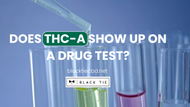Does THC-A Show Up on a Drug Test?
April 30, 2024

Tetrahydrocannabinolic acid (THC-A) is a naturally occurring compound found in the cannabis plant. While it is non-intoxicating in its raw form, it can present complexities when it comes to drug testing. The question of whether THC-A will show up on a drug test is not straightforward, and understanding its relationship with drug screening methods requires a closer look at its metabolic pathways and detection thresholds.
When a person consumes THC-A, whether by smoking, vaping, or ingesting, the body metabolizes THC (tetrahydrocannabinol), the psychoactive compound responsible for the "high" associated with cannabis use. As THC is metabolized, it breaks down into various metabolites, including 11-hydroxy-THC and THC-COOH. These metabolites are what drug tests typically target to detect cannabis use.
Now, here's where THC-A enters the picture. In its raw form, THC-A does not produce the same psychoactive effects as THC. However, when cannabis is heated through processes like smoking or vaping, THC-A undergoes decarboxylation, converting into THC. As a result, if a person consumes cannabis that has been decarboxylated, they will likely have detectable levels of THC and its metabolites in their system, which can be detected by standard drug tests. We do not advise combusting THC-A flower if you expect to have a drug test for THC in the near future.
It's essential to understand that most drug tests are designed to detect THC metabolites rather than THC-A directly. However, some tests, particularly those with higher sensitivity, may also detect THC-A, especially if the consumption of THC-A has been decarboxylated, recent, or in large quantities. The detection of THC-A in drug tests can vary depending on the type of test used, its sensitivity, and the individual's metabolism.
Urine tests are the most common method used for drug screening due to their convenience and cost-effectiveness. These tests typically screen for THC-COOH, the primary metabolite of THC, which can be detected in urine for several days to weeks after cannabis use, depending on the frequency and amount consumed. While urine tests primarily focus on THC metabolites, most tests can also detect THC-A if its levels are sufficiently high.
Blood tests, although less common, can provide a more immediate indication of recent cannabis use. THC and its metabolites can be detected in blood shortly after consumption, making blood tests more suitable for detecting recent cannabis use within a few hours to days. Similar to urine tests, blood tests can detect THC-A if it has been converted to THC and metabolized by the body.
Saliva tests are another option for drug screening, particularly for detecting recent cannabis use. These tests can detect THC and its metabolites shortly after consumption, typically within a window of a few hours to a couple of days. Like urine and blood tests, saliva tests also detect THC-A if its levels are high enough.
Hair follicle tests offer a longer detection window compared to other methods, spanning several months to even years. These tests are less common for routine drug screening due to their higher cost and longer turnaround time but the tests can provide a comprehensive history of cannabis use. THC and its metabolites become incorporated into hair as it grows, allowing for a retrospective analysis of drug use patterns. While hair follicle tests primarily focus on THC metabolites, THC-A could be detected if its consumption has been significant.
Overall, while THC-A is not the primary target of most standard drug tests, it can be detected. The conversion of THC-A to THC through decarboxylation and subsequent metabolism by the body will result in detectable levels of THC and its metabolites, including THC-COOH, which are the primary markers used in drug testing. Individuals who consume THC-A, especially in large quantities or through methods that involve decarboxylation, should be aware of the potential for THC-A to show up on drug tests. As always, it is crucial to consider the type of test being used, its sensitivity, and the timing of cannabis consumption when interpreting drug test results.
